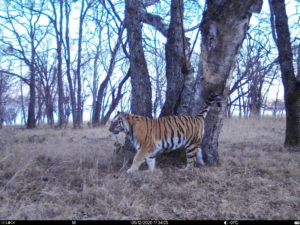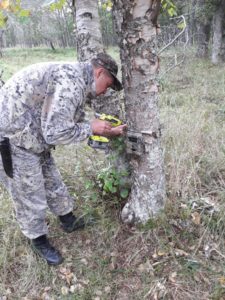Over the past 13 years (2008-2020), ZSL has worked with partners United Administrations of Lazovsky Zapovednik and Zov Tigra National Park (UALZZT) using camera traps and conducting snow track surveys to monitor tigers in the Russian Far East. The data suggests a growing but still fragile population.
With support from WildCats Conservation Alliance, this tiger conservation project in Southeast Primorsky Krai developed into a holistic programme for tiger conservation that included supporting the National Park to implement improved management plans that have increased the effectiveness of anti-poaching activities in the area and continued wildlife veterinary capacity building and strategic planning.
As this recent report shows this respected project has been able, through long term camera trapping, to follow the generations of families of local Amur tigers from year to year, building up a crucial understanding of population dynamics. This study in 2020 highlighted the survival of two cubs in 15-year old tigresses’ (Sabrina) 5th litter (“Sabrina” is the oldest recorded territorial female Amur tiger) to at least 1 year of age and photographic evidence that 14-year old male tiger “Yasha” survived (the oldest and longest continuously monitored male Amur tiger) with an injured tail.
Though monitoring efforts of tigers in the Russian Far East were slowed during COVID19 pandemic travel restrictions, surveys were completed and conservation work proceeded.
Project achievements and activities:
- Conducted tiger population monitoring surveys using 121 paired camera traps covering 3,000 km2
- Data analysis suggests 17-22 adult tigers with a density of 0.62-0.67 adult tigers per 100 km2
- Eleventh consecutive year implementing SMART patrols in UALZZT and helped train 4 new inspectors recruited to use SMART in their patrols
- Produced 12 monthly and 4 quarterly SMART reports used to adapt strategic anti-poaching management
- 46 rangers in 7 groups patrolled an averaged of 26 days and 14-night patrols per month to patrol over 21,000km by a variety of means including along the coastline by boat
- Recorded 20 illegal actions which resulted in written citations including the Rapid Response Teams (RRT) successful apprehension of Lichen collectors
- Two new rangers were trained for SMART patrols and 3 patrol group leaders were trained to use a smartphone app equivalent to CyberTracker
- Equipped RRT with 4 additional GMS poacher cams and 10 regular poacher cams for use with cell service is lacking
- Lost some data because 19 (an unusually large number) camera traps were stolen
The team also produced one publication: Gilbert M, et al. 2020. Distemper, extinction, and vaccination of the Amur tiger. Proceedings of the National Academy of Science 117(50):31955.

Amur tigress Sabrina at 15 years old © Ano Amur/ZSL

Attaching a camera 2020 © Ano Amur/ZSL

Winter patrol conditions © Ano Amur/ZSL

